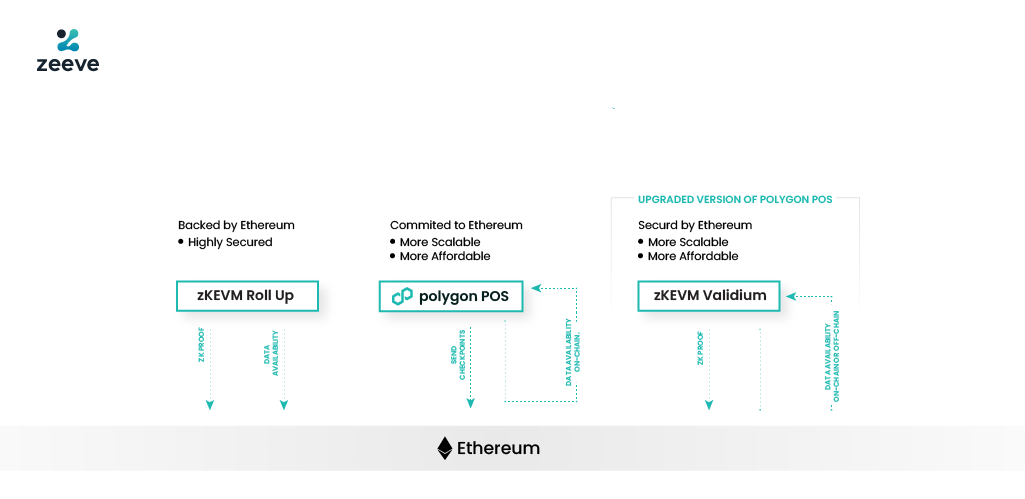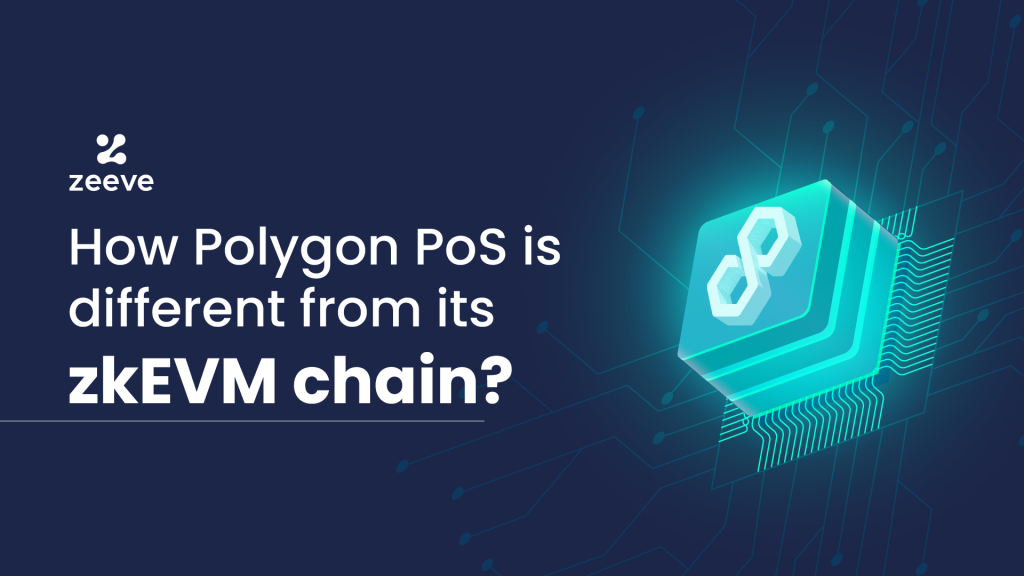Diving deep into the nuances of both Public blockchains
Polygon PoS and Polygon zkEVM are two different public blockchains within the Polygon ecosystem, each with its own characteristics and role. In this article, we will explore the main differences between Polygon PoS and Polygon zkEVM across architecture, capabilities, use cases and roadmaps. Understanding the nuances of both layer 2 scaling solutions empowers developers to pick the ideal platform.
Diving into the Technical Architectures
Polygon PoS relies on a Plasma framework in conjunction with a Proof-of-Stake (PoS) based consensus mechanism to implement a sidechain that runs in parallel to Ethereum mainnet. This sidechain offers increased bandwidth for transactions while still benefitting from the security guarantees of Ethereum.
In contrast, Polygon zkEVM employs ZK-rollup technology to provide a layer 2 scaling solution directly on top of Ethereum mainnet. ZK-rollups allow intensive computation to happen off-chain, while succinct cryptographic proofs are generated and submitted on-chain to attest the correctness of all off-chain activity.
Delving deeper into the Polygon PoS and Polygon zkEVM difference, let’s discuss their distinct technical architectures.
Consensus Mechanisms
Polygon PoS relies on around 100 PoS validators who stake MATIC tokens to participate in consensus and validate transactions on the sidechain. Block producers are selected deterministically based on the largest staked deposits.
In comparison, Polygon zkEVM leverages highly permissionless Consensus Contracts that coordinate a decentralized network of Proposers and Verifiers to batch transactions off-chain and generate proofs. Proposers (sequencers) propose blocks of transactions, form validity proofs and submit to chain. Verifiers sample and verify the proofs before confirming blocks. No staking or special roles required.
This key difference around consensus between Polygon PoS and zkEVM arises due to the fact that PoS is a direct consensus mechanism that requires validators to attest state, whereas zkEVM relies on validity proofs where multiple parties can participate freely to build proofs of correctness.
Data Availability
On Polygon PoS, all transaction data and state is readily available directly on its sidechain. Having data on-chain allows for fast retrieval and cross-referencing, which aids in tasks like reconciliation. But it comes at the cost of extra storage overhead on the sidechain.
In comparison to Polygon PoS, Polygon zkEVM offers a couple of different data availability options:
Validium – Data is maintained off-chain in this mode, offering storage efficiency. Only validity proofs are posted to Ethereum mainchain. Retrieval is slower but verification is faster.
Volition – A hybrid option where certain data deemed crucial can optionally be stored directly on-chain while the rest remains off-chain. This offers a balance between efficiency and faster access.
By optimizing data availability, ZK rollups are able to reduce the burden and fees for data storage on the mainchain.
Interoperability and Bridges
A key difference arises in interoperability with Ethereum. Polygon PoS has a separate isolated sidechain running in parallel to Ethereum. Assets can be transferred between the sidechain and mainchain via bridges, but there is no direct interoperability. It validates transfers via PoS validators and confirms delivery. The PoS chain and Ethereum remain separate networks only connected by the bridge.
Adding to the Polygon PoS and Polygon zkEVM difference, The zkEVM bridge enables asset transfers between zkEVM and other networks like Ethereum mainnet using “lock” and “mint” functions and wrapped tokens. It utilizes exit trees and Global Exit Tree roots to synchronize state between source and destination networks. It utilizes exit trees and Global Exit Tree roots to synchronize state between source and destination networks.
Analyzing Core Capabilities:
There are several core capability differences between Polygon PoS and zkEVM in areas like throughput, fees, finality guarantees and more:
Smart Contract Execution
Polygon PoS offers EVM-compatibility by utilizing the Ethereum Virtual Machine to execute smart contracts on its sidechain. This allows developers to port Solidity contracts from mainnet to PoS with minimal changes. However, there can be subtle execution differences between EVM on mainnet versus sidechains. So, in some cases where developers need to deal with intricate dapp configurations or may be low-level code, they might have to make certain changes for sidechain-specific features when working with PoS chain.
Polygon zkEVM aims for full EVM-equivalence, which guarantees compatibility and identical execution as Ethereum mainnet. This allows developers to deploy unmodified contracts and tooling from mainnet to zkEVM for a frictionless experience.
Hence, Polygon zkEVM is kind of a near-perfect replica of Ethereum’s execution environment. But Polygon PoS is focused on offering compatibility with Ethereum smart contracts EVM within the context of a sidechain.
Throughput
Polygon PoS has a theoretical limit of achieving 7200 TPS, but in reality they have seen throughput of around 1000 TPS. High throughput is determined by the gas limit.
In comparison, Polygon zkEVM also aims to achieve a similar kind of throughput like PoS, but basically because of the rollups architecture, and higher security the throughput could be little less compared to side chain. Though actual throughput will depend on implementation details.
Fees
Both networks offer highly cost-efficient transactions compared to native Ethereum mainnet. However, Polygon zkEVM generally has marginally higher fees than Polygon PoS currently, though still negligible in absolute terms. At the moment, the average transaction cost on the Polygon PoS chain is somewhere around $0.015/transaction.
This minor fee difference arises because the Validity Proofs required by zkEVM require more complex computation than PoS consensus, impacting fee economics slightly. Average cost for transaction is 0.000070 ETH/$0.11 for zkEVM
Finality
Finality refers to the time taken for a transaction to be considered irreversible. Polygon PoS offers fast finality of around 1 minute due to its high speed sidechain.
Here the key difference between Polygon PoS and zkEvM is that, Polygon zkEVM can offer nearly instant finality for transactions since validity proofs submitted on Ethereum provide probabilistic finality as soon as they are verified.
Use cases & Adoption:
Due to their different capabilities, Polygon PoS and zkEVM are suited for different applications:
Because of the high throughput and negligible fees, Polygon PoS is better suited for applications where the dApp needs to handle high volume transactions. It could be trading applications, Web3 gaming and social dApps, micro DeFi and similar applications.
Polygon zkEVM is ideal for use cases like high-value DeFi applications, Yield firming where the security is the priority even if fees are slightly higher, but don’t require very high throughput.
Talking about the adoption, The PoS ecosystem has considerable maturity with over tens of thousands of dApp deployed on the chain. The current TVL is $687M. The PoS chain powers the most popular brands in their web3 efforts. Reddit, Stripe, Starbucks, Bulgari, and many more are on Polygon.
On the other hand, zkEVM ecosystem is quite new but rapidly expanding too with many major projects migrating to it to meet their requirements and take the benefit of Zero-knowledge proofs. It’s current TVL is around $56M.
The EVM equivalence of zkEVM allows projects to deploy unmodified contracts from Ethereum with minimal friction. This makes it easy for Ethereum native applications to “go multi-chain” on zkEVM. Emerging segments like passwordless authentication, private transactions, confidential computing etc would also gravitate to the privacy guarantees and validity proofs offered by zkEVM.
PoS to zkEVM Validium Upgrade
Polygon is considering upgrading its existing PoS network to use zkEVM validium architecture. This would allow Polygon PoS to leverage zero-knowledge proofs to verify the validity of transaction batches that are executed and stored off-chain. The goal is massive improvements in scalability.
The upgrade aims to retain the capabilities of high throughput, low fees, and EVM compatibility that have made Polygon PoS popular – while also gaining the benefits of zkEVM’s security proofs and interoperability.

Some key advantages of this zkValidium transition:
- Adds security of zero-knowledge validity proofs to the fast, low-cost transactions of Polygon PoS.
- Allows hybrid models and optional on-chain data availability enforced by blockchain.
- Significantly boosts scalability as validiums reduce data burden on Ethereum compared to rollups/sidechains.
- Validity proofs provide higher security guarantees than a standalone sidechain like Polygon PoS.
- Creates an EVM-compatible validium, combining flexibility to support existing EVM apps and tools while improving scalability/security.
- Leverages zero-knowledge proofs to validate transactions upfront, avoiding limitations like challenge periods faced by other scaling solutions.
In summary, this upgrade aims to transition Polygon PoS into an EVM-based zk validium that retains the capabilities and community of PoS while also unlocking interoperability, scalability, and security through integration of zkEVM innovations. The goal is the best of both worlds for developers and users.
Let’s start building:
In summary, Polygon PoS and zkEVM offer two complementary layer 2 scaling models with divergent architectures, capabilities and applications. Polygon PoS caters to high-volume use cases by providing a high-speed, low-cost EVM-compatible sidechain secured by PoS validators. In contrast, Polygon zkEVM prioritizes EVM equivalence, uncompromising security and interoperability by relying on validity proofs submitted to Ethereum. By understanding the Polygon PoS and Polygon zkEVM difference in aspects like architecture and adoption, developers can make more informed choices to pick the right long-term scaling solution for their Web3 applications on Polygon.
If you are looking to deploy a Polygon PoS node or a zkEVM node for your web3 applications, give a visit to Zeeve today. We support all the leading public blockchains protocols with full, archive and validator node deployment, provide custom appchains and rollups deployment services with all the additional infrastructure component included.
Get in touch with our Zeeve experts and see how Zeeve can simplify your blockchain and web3 deployment journey.























